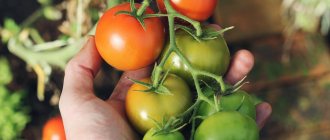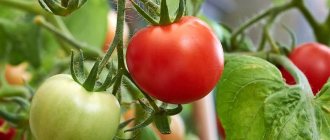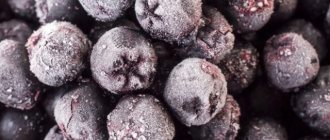How to store green tomatoes so they turn red
For storage, regardless of the timing, the fruits are sorted. Those that have damage or brown spots are immediately discarded. It is important that the tomatoes are firm and firm. Even a slight bruise will cause the tomato to quickly rot. Slightly wilted fruits will also not be stored for long. Green tomatoes are best stored when they are large to medium in size. Small fruits also need to be discarded.
It is best to store unripe tomatoes in a dark room with little humidity. Exposure to sunlight is not recommended. It is also very important to maintain a certain temperature regime.
Temperature directly affects the duration of ripening of tomatoes.
When you need to speed up the process, it is raised, but if you need to keep the tomatoes green, then the temperature should be lowered.
- For example, at a temperature of +25°C, fruits can ripen in a week.
- At +15°C, the ripening period extends to 12 – 15 days.
- If the temperature does not exceed +10°C, the tomatoes can remain as green as they were for up to two months.
If you harvest in October and store it at the right temperature, you can ensure that fresh tomatoes are on the holiday table for the New Year holidays.
| Ripening period | Temperature |
| About a week | + 25°C |
| 12-15 days | +15°С |
| Up to two months | +10°С |
To do this, it is enough to increase the temperature by 5 degrees before the New Year, and in two weeks you will get red fresh tomatoes. Varieties that do not have too large fruits are stored at +10°C for up to 3 months.
Before deciding under what conditions to store tomatoes, they are sorted by degree of ripening.
- Absolutely green fruits are stored at temperatures from +8°C to +12°C.
- As for tomatoes that have already turned red in some part, they can be stored for up to 1 month at a temperature of +4°C to +6°C.
- Completely red fruits can be kept at +2°C for up to 5 - 6 weeks.
Proven ways to preserve ripe tomatoes longer at home
There are several proven methods, each of which involves preserving the fetus for a certain period of time. But in order to store tomatoes, you also need to take into account all the above general recommendations. After all, teamwork of all requirements is important in this matter.
- The most important condition for proper storage of already ripe tomatoes is the absence of excess moisture . Regular newspaper helps remove excess moisture. To store tomatoes in this way, you need to wrap each of them in newspaper and place them on the refrigerator shelf. If you have a basement, then even better - place the tomatoes, wrapped in newspaper, in plastic or wooden boxes. By the way, also wipe the shelf or drawers thoroughly to avoid excess moisture. Of course, the newspaper should be changed periodically so that the stored fruits remain dry at all times. You shouldn’t make many layers; the ideal option is a maximum of 2 tiers. Otherwise, the fruits may put pressure on each other, release juice and quickly deteriorate.
- When they are dry, put them in a jar. We do this freely so that they do not crush each other. Sprinkle a layer of tomatoes with mustard powder, then place paper on top and repeat the procedure again. Thus, fill the jar and roll up the lids. Jars closed using this method are best stored in a dark, cool room; a cellar is ideal for this.
An excellent way is to store tomatoes in paper.
What to consider when storing green tomatoes
- There are varieties of tomatoes that cannot be stored for a long time. When storing tomatoes, you need to remember this.
- Be sure to sort through the tomatoes to immediately throw away those that have begun to spoil. This culling is carried out 1 – 2 times a week.
- You cannot store tomatoes in plastic bags. Moreover, close them. Constant access of air to the fruits will protect them from the development of mold and rot.
- Unripe tomatoes should not be exposed to sunlight. Of course, many housewives are accustomed to placing them on the windowsill, but it is better not to do this.
Harvesting and sorting
To preserve tomatoes longer, it is better to pick them unripe . Ripe fruits are not protected - they have thin, delicate skin, they quickly deteriorate.
Tips for picking tomatoes:
- You need to harvest the crops during the day so that the fruits dry out from the morning dew - excess moisture harms the vegetables.
- If it is not possible to work during daylight hours, the collection can be moved to the evening, but keep an eye on the temperature; it should not drop below 9 degrees.
- For storage, select undamaged fruits when they have acquired milky ripeness - they have reached the size of ripe tomatoes, but have not turned red or yellow.
- Do not remove frozen tomatoes; they will not survive on the bush.
- For additional disinfection, you can wipe the fruits with alcohol.
Important! Tomatoes grown in open ground will last longer than greenhouse tomatoes.
Where to store
There are several options for storing green tomato harvests. They can be used in apartments, cottages, and country houses.
Boxes
The material of the container is not important.
Cardboard, plastic, and wooden boxes are suitable. The bottom must be covered with several layers of newspapers. Place the tomatoes in layers, each covered with a layer of paper. You can use dry straw if the crop will be stored in a utility room. Deep drawers are not needed. One should hold no more than 12 kg. Part of the tomato will choke if you put more than 3 layers in a container. The storage location must be easily accessible. Every 3-4 days it is necessary to check the condition of the fruits and select:
- ripe;
- brown;
- rotten.
Tomatoes starting to turn brown should be placed in a separate box. This will slow down the ripening process of green tomatoes and extend the period of their consumption.
Packages
In an apartment, it is convenient to store green tomatoes in paper bags. The fruits can be wiped with a rag soaked in vodka. The absence of infection will extend the storage period. At a temperature of 18-20 °C, the fruits will turn red after 2 weeks; if the room temperature is not higher than 15 °C, the ripening time will increase to 4 weeks.
In the cellar, tomatoes can be stored in plastic bags. There is no need to tie them. The air should circulate freely. It is better to hang the bags. The temperature in the cellar is low, so the tomatoes will ripen slowly. If necessary, the package can be brought into the room. In a warm room they will quickly turn red.
Banks
If you have glass jars, green tomatoes can be ripened in them.
Convenient to store in a 3 liter container with a wide neck. The filled container should be closed with a lid and placed in a closet or other dark place. To speed up ripening, put a banana or a couple of red tomatoes in the jar. The condition of the fruits must be monitored and removed if signs of spoilage appear. At room temperature, tomatoes in jars ripen in 10 days.
Ripe tomatoes can also be stored in a jar. It must be sterilized in a microwave, oven or steam. Wash the selected fruits, wipe dry and place in a prepared container. Prepare the lid, pour 3 tbsp into the jar. l alcohol, set it on fire, close the lid. There will be no oxygen in the jar due to combustion; ripe tomatoes are stored longer in a vacuum.
Fridge
Both ripe and green tomatoes are stored in the vegetable compartment of the refrigerator. For long-term storage they are placed in bags. The fruits are pre-wiped dry. There should be no condensation in the plastic bag.
Ripe tomatoes can be frozen. Cherries and small cream are frozen whole, and large-fruited varieties are cut into slices (circles, quarters, cubes). You can use frozen tomatoes when preparing pizza, meat and vegetable stews, pilaf, and borscht.
On the bushes
Healthy bushes with green tomatoes can be dug up with a lump of earth. If there is a heated greenhouse, then bring them there and bury them. If you don't have one, you can use the barn. Place the bushes in buckets and cover the roots with soil.
The soil will have to be moistened periodically. Only healthy plants without signs of late blight, powdery mildew and other fungal diseases are suitable for this storage method. On bushes, small fruits will increase in size.
Everyone's favorite cherry tomatoes are stored differently. The brushes are cut, tied into bunches, and hung in a barn or other utility room. The fruits gradually ripen and are stored for a long time.
Canning
Green tomatoes make excellent winter preparations. To prepare pickled green tomatoes you will need:
- tomatoes 1.5 kg;
- coarse pickling salt 400 g;
- wine vinegar 800 ml;
- olive oil 500 ml;
- oregano to taste;
- some hot red pepper (dried).
Small varieties are suitable. The fruits need to be washed, cut into halves, poured into a basin or pan, sprinkled with salt, and left for 5 hours. Liquid will release; to get rid of it, drain the tomatoes in a colander and return them to the pan.
Pour in vinegar, after 12 hours put it back in a colander. We sterilize jars. Place the dried tomatoes in prepared containers. Sprinkle each layer with spices (oregano, pepper pieces). Pour olive oil into jars and roll up. The preparation can be eaten after a month.
Why is it necessary to remove unripe tomatoes?
There are several objective reasons; if they exist, experienced summer residents remove unripe tomatoes from the bushes without further hesitation. The reason is both the unpleasant symptoms of a fungal disease (powdery mildew, late blight) and a large harvest.
When signs of disease appear, formed fruits are collected from the bush, and the plant is treated with a fungicide solution. If the bush overcomes the infection, the remaining ovaries will develop safely and the green tomatoes will ripen.
On a note!
Before storing fruits from a diseased bush, they are washed, immersed in water heated to 60 °C for 3 minutes, and wiped dry.
A healthy bush overloaded with fruits may have branches that break. By removing part of the crop, the summer resident reduces the load on the vines. It's not just ripe tomatoes that need to be picked. Brown, green fruits that have reached medium to large size are also collected.
Prolonged bad weather (rain) can lead to tomatoes cracking and rotting. Preserve the harvest by timely harvesting and proper storage. Don't delay picking tomatoes in August when the nights get cold.
The signal for harvesting is the appearance of the first yellow leaves on the bushes. Fruits picked at the right time are stored longer, do not rot, and ripen well. In cold weather, tomatoes at home will turn red faster than on the bushes.
This is important to know: which picked tomatoes are suitable for ripening?
To obtain maximum yield, the most delicious varieties of tomatoes, mid-late and late, require thoughtful formation of the bush. In the conditions of the Central region, in an open ground bed, 3 lower clusters of tomatoes ripen, and then only under favorable circumstances.
Even if you carefully follow all the recommendations of agronomists, no one is immune from the fact that the tomatoes do not have time to ripen:
- All plans for the harvest can be disrupted by weather. Cold nights or wet, rainy weather are not conducive to the ripening of tomatoes. To protect the crop from rot, tomatoes must be removed.
- Not all summer residents mercilessly pinch the top of the bush immediately above the 3rd flower cluster. Due to forgetfulness, busyness, excessive pity for the plant or the desire to grow more crops, at the end of summer the bush is hung with green tomatoes of various sizes.
Summer residents know that tomatoes picked from the bush can ripen on their own.
This pattern does not always work. Instead of juicy red tomatoes, after a couple of weeks of ripening, you can end up with unappetizing, wrinkled tomatoes.
Another option is also possible: tomato fruits picked green will not turn red, but will rot. Not all green tomatoes are suitable for fruit ripening.
Extending the shelf life of fresh tomatoes
Tomatoes of mid-late and late varieties, picked in a state of milky-waxy ripeness, can ensure the daily presence of fresh tomatoes and dishes made from them on the menu.
Long-term storage of varieties such as “De Barao”, “Rio Grande”, “Bull’s Heart” and similar varieties with dense pulp and strong skin is best. For storage during ripening, it is advisable to collect tomatoes together with the stem.
The numerous varieties of “Cherry” that are now popular are well stored directly on the branches, tied in bunches and hung in a cool place.
Which unripe tomatoes should you take?
In the event of an unexpected cold spell or the risk of crop loss from late blight, it is better to remove all the fruits in advance, without waiting for the outbreak of an epidemic of fungal diseases and rot. Tomatoes picked unripe can be stored much longer than usual, until the New Year.
For ripening, it is necessary to take only strong and elastic fruits. The matte surface of a tomato indicates a possible late blight infection - it is better to keep such fruits separately and quickly use them for food.
Tomatoes of varying degrees of ripeness - green, milky-waxy, brown, almost ripe - it is advisable to ripen separately.
Since large tomatoes ripen first, small ones much later, it makes sense when storing for ripening to sort the fruits not only by degree of ripeness, but also by size.
Fruits that have reached their characteristic size are suitable for ripening; the degree of ripeness does not matter - green, brown, milky-waxy ripeness or almost ripe. It is preferable to remove them from the bush in dry weather, if in the morning - after the dew has disappeared.
Myths and reality
If you wander around the Internet, you can read a lot, but each line is worth thinking about:
- “To ripen, tomatoes must be covered with a red cloth.” This is probably outright quackery, although if you want to have your own opinion on this matter, then try it. It is advisable, of course, to keep the experiment clean and cover one box with a red rag and the other, for example, with a green one. And please share your research results in the comments.
- Mustard powder also does not help ripening. If the tomatoes have turned black, it won’t help either.
But it’s true that when you add a ripe apple or one that’s starting to rot to green tomatoes, unripe tomatoes ripen faster.
Do you know what ripe fruits smell like? That's right - delicious. They smell like ethylene with aromatic substances. The riper the fruit, the more gas it releases and contributes to the redness of its neighbors.
At the beginning of the last century (1936), a work was published at the Peterhof Biological Institute on the effect of ethanol (medicinal alcohol) on stored tomatoes. So, when 0.2 ml of vodka was introduced into the pulp of a tomato, first the injection site began to turn red, and then the fruit itself, and evenly. This did not affect the taste.
Ripening of “drunk” tomatoes takes place 10-12 days earlier than “sober” ones. Another interesting fact is that “drunken” tomatoes produce seeds with excellent seedlings.
Tomato processing
If it is not possible to preserve fresh fruits for a long time, red, green, and brown tomatoes can be processed.
Recipe for tomato juice from yellow tomatoes:
- Wash the tomatoes and run them through a juicer.
- Pour the resulting liquid into a saucepan and bring to a boil. Cook for 10 minutes, stirring, skim off foam. You can add salt and sugar to taste, or you can add nothing.
- Pour the finished product into clean jars and roll up.
What determines whether tomatoes ripen?
You ask, how to properly store green tomatoes at home so that they ripen? Before I started harvesting, I became familiar with the factors and conditions that affect the quality of storage.
Having learned the rules for preparing and preserving the product, it was not difficult for me to get the desired result. I will explain on what conditions the ripening of fruits depends.
- I buy green ones at a trusted retail outlet, at the market from old women; they don’t spray them with chemicals.
- I choose ones with stalks, this indicates the freshness of the product.
- If there are none on the branches, I choose fruits without damage or stains.
- With a smooth, shiny surface.
- I prepare before the first frost (in the southern region the ideal time is the end of September, in the central region - the end of August).
Look at the video on how to ripen a green tomato:
There is no way to purchase goods on the market? Learn how to grow tomatoes on a windowsill and you will always have fresh vegetables at hand for the table.
Why tomatoes don’t have time to ripen on the vine
Harvesting green tomatoes is a necessary measure that allows you to save the much-desired harvest. But why do we have to face such a situation every autumn? There may be several reasons for prolonged and untimely ripening:
- Wrong choice of variety. For growing outdoors, you should prefer early-ripening varieties of low- or medium-sized tomatoes. In this case, the plant will not spend a lot of time growing green mass and will form ovaries in a timely manner. Tall varieties of tomatoes can be grown in greenhouses, where optimal temperatures are artificially maintained until mid-autumn.
- Violation of plant care rules. In order for tomatoes to ripen quickly on the root, you need to properly shape the plants by removing the stepsons and pinching the tops. At the end of the fruiting season, it is recommended to feed tomatoes with potassium fertilizers, reducing the amount of nitrogen to a minimum.
- Late planting of seedlings.
- Lack of sunlight. The reason may be caused by bad summer weather and in this case it is almost impossible to correct the situation. It’s another matter when tomatoes grow near tall bushes and trees. In this case, you can facilitate the penetration of sunlight into the tomatoes, which will speed up their ripening.
- Early arrival of autumn cold.
Unfortunately, the farmer can influence only some of the above reasons, but if there is such a possibility, then next year you should definitely try to eliminate past mistakes and be more careful in choosing a variety, growing location, and timing of sowing seeds for seedlings. Perhaps in this case it will be possible to collect a mature harvest in full from the garden.
Important! Ripening of standing tomatoes occurs at a temperature not lower than +150C.
Always with tomatoes
An experienced summer resident has ripe tomatoes on the table from June until the new year. It turns out for those who are not lazy:
- spend time choosing a variety, plant early, mid-early, late;
- sows seeds for seedlings at different times;
- carries out disease prevention;
- Harvests regularly.
All collected fruits require sorting, some are suitable for long-term storage (green), others should be ripened quickly (brown, white), and others should be processed (red). Fruits picked from diseased bushes are stored separately. They can be immediately sent for processing using popular recipes for preparations.
Which tomatoes to choose for storage. Varieties and when to collect?
It is recommended to harvest tomatoes when they are not ripe.
The first mature tomato produced by domestic breeders is Giraffe. The variety has large yellow spherical fruits with a strong skin.
It is recommended to harvest tomatoes when they are not ripe, as they will last up to six months. In order for the fruits to ripen faster, you need to place blanje tomatoes next to them in the box.
Storage varieties:
- Red stone is a dense, medium-sized fruit.
- Decembrist is large (weighs 250 g), the skin is pink.
- Lond keeper - ripe fruits of pearl pink color, stored until the New Year holidays.
- Masterpiece - yellow-orange fruits.
Read more ► How to store beans at home?
The specially bred, easy-growing variety New Year's, ripens by winter. The fruit is flat-round, yellow, weighing 100 g; leaf, stipule of unusual shape - large, lobed, externally different from other varieties.
Unripe fruits grown in a greenhouse can be stored for up to six months.
Important! The harvest of mature varieties is harvested late, those grown in a greenhouse - in October-November.











